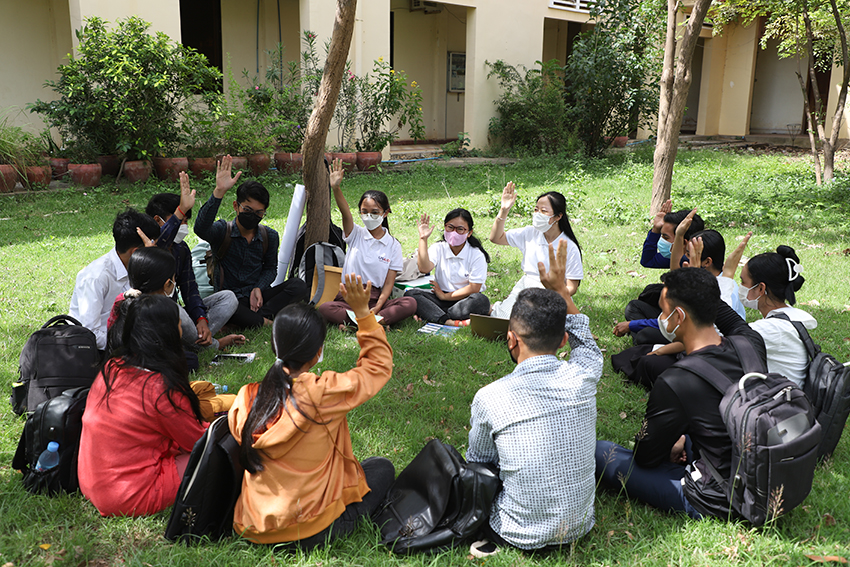
Members of a Green Group in Phnom Penh, Cambodia, discuss communication strategies to engage their communities on how to live more environmentally friendly lives. Green Groups are the central part of the USAID Cambodia Green Future Activity, which empowers young Cambodians to be change agents in the fight against climate change. Photo credit: Maly Phou/FHI 360
On a sunny August day in Phnom Penh, Cambodia, a dozen people ages 15–24 sit in a circle on the grass outside of the Prek Leap National Institute of Agriculture. They aren’t discussing the latest viral video or school gossip. Rather, they are exploring how communication strategies can help their families, peers and communities understand the negative effects of some of Cambodia’s most environmentally damaging behavior trends — and how they can live more environmentally friendly lives.
These young people are members of Green Groups, the core component of the USAID Cambodia Green Future Activity, a five-year project which I help manage as the deputy chief of party. This initiative supports youth to engage their communities on three topics: decreasing demand for luxury wood furniture, reducing the consumption of bushmeat and curbing littering.
Based on my experiences with these groups, young people in Cambodia are motivated to act against environmental issues that threaten global health and well-being, and they are more aware than ever of the realities of climate change. And I believe that the participants are not the only ones. With the right tools, young people can spark positive change within their families, social circles and communities.
Building world-changing connections
The Cambodia Green Future project mobilizes youth leadership for climate action by providing opportunities for young people to connect with one another, equipping them with leadership skills and tools to enable them to lead climate action activities. By helping young environmental advocates meet like-minded peers, the project amplifies their voices and supports them to adopt more sustainable and environmentally friendly habits.
“As an environment lover, I’ve seen a lot of problems,” says 21-year-old Pechpheary Nann, a Green Group member.
Nann has concerns around climate change, deforestation and littering. “I really want to be part [of solutions] for those issues,” she says. “[My Green Group peers] are from different universities, [but] we have the same goals.”
Having experienced firsthand how purpose-driven connections can fuel young people’s ambitions to challenge the status quo toward a healthier world, I am hopeful for a brighter future for Cambodia and the planet.
Strong alone, but stronger together

This flyer is part of the Green Group’s social and behavior change communication toolkit. Photo credit: Maly Phou/FHI 360
We equip Green Group members with social and behavior change communication toolkits and collaboration opportunities with a professional creative agency to help them serve as climate action leaders. They then lead their projects, while FHI 360 and our partners support them with the tools they need to succeed as change-makers.
Nann’s group has six people. “We come up with ideas [and] solutions,” she says. “We start small and share with others, [so that] our group actions will lead to other people or groups taking action just like us.”
Through the Green Groups, the project is helping young Cambodians act against environmental degradation. Last year, we conducted a midpoint survey using a representative sample of 500 young people ages 15–24 in Phnom Penh and three rural Cambodian provinces. The results showed a 32 percentage-point increase (from 45% in 2020 to 77% in 2022) in the proportion of respondents who understand the importance of biodiversity and forest ecosystems, and an 11 percentage-point increase (from 12% in 2020 to 23% in 2022) in the proportion who often engage in discussions with their friends about biodiversity conservation needs.
Helping the planet depends on local youth leadership
At FHI 360, we know that to have lasting impact, we must advance local leadership, local knowledge and local priorities. And yet, youth rarely hold positions of power in climate-focused conversations, and they are seldom consulted by decision-makers. This is especially significant in Cambodia, where 14- to 30-year-olds make up over a quarter of the population, but it is also relevant in many countries across Africa, Asia, Latin America and the Middle East, where young people comprise a rapidly growing segment of the population.
Supporting young people as climate action leaders is the ultimate way to capitalize on their technological savviness, worldliness and strong desire to influence others.
It takes a village to raise a climate action leader
From my experiences as a mother and three years of working with FHI 360 on environmental initiatives in Southeast Asia, I have been humbled by young people’s inspiration and motivation to make the world a better place. The 1.2 billion people globally ages 15–24 represent a golden opportunity for fighting climate change and for improving the health of our planet.
![Green Group members brainstorm ideas for how to lead climate action activities. “We come up with ideas [and] solutions,” says Green Group member Pichpheary Nann. Photo credit: Maly Phou/FHI 360](https://degrees.fhi360.org/wp-content/uploads/2023/04/blog-young-leaders-cambodia-post-it-400X287.jpg)
Green Group members brainstorm ideas for how to lead climate action activities. “We come up with ideas [and] solutions,” says Green Group member Pechpheary Nann. Photo credit: Maly Phou/FHI 360
To achieve a world where everyone lives in an environmentally responsible way and actively fights the effects of climate change, young people must have opportunities to set agendas, design solutions, and develop the capacity and resources to make those solutions a reality. Many players — including caregivers, schools, governments and private companies — must get involved to support these efforts on a global scale.
The USAID Cambodia Green Future Activity is funded by the U.S. Agency for International Development (USAID). FHI 360’s partner ECODIT serves as the prime contractor.
